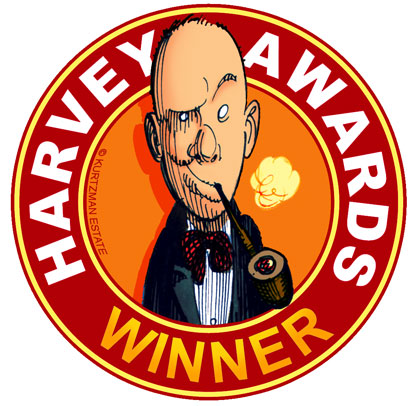Saturday, October 03, 2009
Family Guy takes a shot at editorial cartooning
PR: 2009 Harvey Awards Dinner and Presentation Ceremony Tickets Available
| |
| |||||||||||||||
Comics Riff on Tomorrow
Style Invitational comic strip mashup with Staake

The clever among us should immediately go to the Washington Post's Style Invitational's contest for Week 837: Strip Search, October 3, 2009 to answer the question: Combine two comic strips that appear in The Washington Post or at http://www.washingtonpost.com/comics . This was probably somewhat inspired by all the recent Disney-Marvel mashups, but I like Bob Staake's take on Dilbert - Spider-Man. Feel free to write to me if you have a question about a strip in the print edition.
Thursday, October 01, 2009
Baltimore Comic-Con 2009 First Annual Costume Contest, More!
| ||||||||||||||
Cartoons at Saturday brunch in Arlington
Looking for Calvin and Hobbes booksignings
Oct 29 at 7-9 PM - Bethesda, MD at Big Planet Comics
http://www.bigplanetcomics.com/index.htm
Nov 19 in Baileys Crossroads, VA at Borders
http://www.borders.com/online/store/StoreDetailView_45?schid=GLBC|Baileys+Crossroads+VA|45
Crafty Bastards fest this weekend
The Washington City Paper’s annual Craft Bastard festival is Saturday, Oct 3, 10-5 in Adams Morgan. There’s usually cartoonists there. Rob Ullman will definitely be there, and I’m sure the City Paper’s Ben Classen will also.
Disney film opens at E Street Cinema
According to today’s Express, the documentary Walt and El Grupo opens tomorrow at the E Street Cinema at 555 11th St. This film looks at Walt Disney’s good will tour of South America, which resulted in The Three Caballeros and some characters we rarely see that are popular in the rest of the world.
Comic Riffs poll on Cul de Sac
Wednesday, September 30, 2009
Book review: Looking for Calvin and Hobbes
Martell, Nevin. Looking for Calvin and Hobbes: The Unconventional Story of Bill Watterson and His Revolutionary Comic Strip. New York: Continuum, 2009. $24.95.
ISBN-10: 082642984X, ISBN-13: 978-0826429841
Nevin Martell has written a curious book, although one would probably best consider it a biography. Bill Watterson so consistently shunned the media that one is put in mind of the Shakespeare biography industry in which a few facts are churned in an attempt to generate a larger picture of a life. Readers of a certain age may end up recalling Leonard Nimoy's syndicated television show, In Search Of, in which apparently mythical beasts such as the Loch Ness Monster or the yeti were diligently pursued for an hour. A better analogy might be In Search of Lost Time, as, like Proust, Martell seeks both Watterson's youth, and by extension, his own.
To his credit, while lacking Watterson's cooperation, Martell avoided writing a book that just looks at his favorite Calvin and Hobbes strips. The book covers Watterson's school life and his earlier attempts at comic strips and editorial cartooning. Martell goes into some detail looking at the influences that Watterson claimed – Charles Schulz, Walt Kelly and George Herriman, relying largely on Watterson's writings in published collections. He covers the main characters, storylines and tropes of Calvin and Hobbes, as well as the history of the strip and Watterson's relationships with the media and his syndicate. Both of these relationships were prickly, as were his relationships with other cartoonists as he rarely participated in social activities nor accepted the awards they voted him.
Martell demonstrates how Watterson's eventual pursuit of a Platonic image of a comic strip, in which licensing and commercialism never played a factor, led to his quitting the field. This unrealistic view is gainsaid by the actual history of comics which were merchandised as often as possible from their 19th century beginnings in both the US and the Great Britain. Universal Press Syndicate and Andrews McMeel representatives are circumspect in their quotes, but one is clearly left with their negative opinion about the staggering amount of money Watterson "left on the table" by refusing to merchandise his strip.
Since Watterson would not talk to Martell, the author tried to talk to his family and eventually did speak with the cartoonist's mother. He also met with Watterson's friends such as comics historian Rich West and others from Watterson's childhood. Martell also talked to many other cartoonists about Watterson's influence, whether or not they actually know him, and the book takes on a somewhat scattered voice. Martell ends the book with his trip to Chagrin Falls, OH where he speaks with his mother.
In the end, one is left uncertain as to how to consider Watterson. He was at the top of his career, a career the book amply shows how hard he had tried to achieve, and he left it. As a result, he avoided the downturn in quality that many strips have at periods in their lifespans. The reader is then left with the question of whether this is actually a good idea – the comic strip survives as a decade-long achievement – but what is then left unachieved is of course unknown and unknowable. In spite of Watterson's refusal to speak for himself, Martell has written an engaging and informative book while avoiding most of the traps that catch fan writers. The book includes a bibliography and an index. (This reviewer is thanked in the acknowledgements for helping with research).
Michael Rhode
Tuesday, September 29, 2009
Virginia Commonwealth University picks comic book as item 2 million
Mautner and Collins on SPX
Sean Collins has audio of two panels he was on - Comics Time: Two Panels from SPX 2009
and Chris Mautner of the old Comix@ list has his impressions at Comic Book Resources' Robot6.
Finally, I stuck my pictures from 2007-2009 into Flickr's SPX group. They've all been here in the past, but in case you want to see them again...
DC Comic Books Examiner: Small Press Expo discernibly contributes to festive Washington DC weekend
Small Press Expo discernibly contributes to festive Washington DC weekend The last Sept. weekend had less room for a lack of activities across the Greater DC Metro. Outside of sports, namely both National games and Washington's Sunday loss against the Lions, and the political events like the CBCF Legislative Conference,... Read more » Tuesday, September 29, 2009
DC Comic Books Examiner, Mark Ruffin 
| |
Post's Shales on Cleveland Show
'Cleveland's' a Chip Off the Old Crock
By Tom Shales
Washington Post Staff Writer
Tuesday, September 29, 2009
Monday, September 28, 2009
More SPX photos
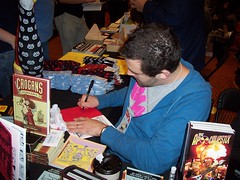
Chris Schweizer. I love his Crogan's Revenge pirate story.
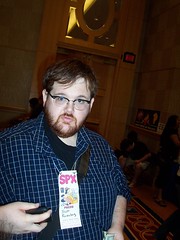
Crack ex-DC journalist Scott Rosenberg.

Steve Conley. Steve was selling original strips from Socks and Barney for an insanely low price so I bought 2. (that's one of Rob Ullman's girls behind him)
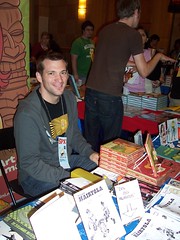
Rob Ullman, the sadly-missed Washington City Paper's Savage Love columnist.
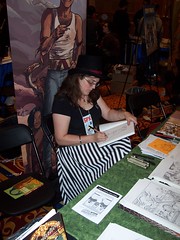
Carla Speed McNeil of Finder

Andy Runton of Owly. Box Brown in the background. Pic by Claire.
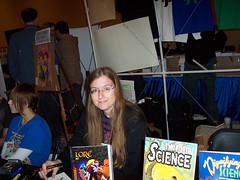
Jennifer Hachigian who does Lore. Pic by Claire.

Jim Ottaviani of GT Labs. Pic by Claire.

Doug "Pop Culture Shock Therapy" Bratton and John "Bo-nanas" Kovaleski. I wasn't familiar with Bratton's work but bought a complete set. I think I've got a full set of John's except for minis.

John Kovaleski
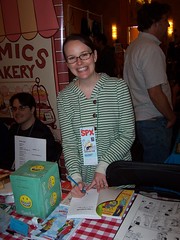
Raina Telgemeier. Pic by Claire.
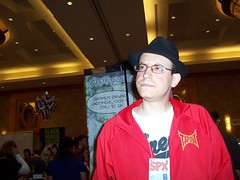
Ed Piskor. Pic by Claire.
Ben Towle on SPX
Dilbert made somebody's job easier
Cavna and Thompson address new feature and turfing of CdS
Post magazine editors want you to embrace change
Here's the relevant sections from their chat. Cul de Sac was dismissed with "we had a note to tell you where to find it":
chi-town: Sad that "Editor's Query" has disappeared. Loved those.
What exactly is the point of "Our Town?" I like Michael Cavna and his work with Comic Riffs, but I didn't really understand the point of the Our Town illustration. Was he actually there, drawing the sights? Is this what it will be every week? Because 1) I imagine it will get old after a few weeks, and 2) I think it would be better in photograph form. Cavna's artistic abilities would be better suited for some other feature...maybe a "Six Chix" type of arrangement with rotating artists but more comic-strippish.
washingtonpost.com: Our Town (Post Magazine, Sept. 27, 2009)
Debra Leithauser and Janet Michaud: The point of Our Town is to capture a slice of life in the metro area, as told via artwork rather than a traditional story. And, yes, Cavna certainly was there.

